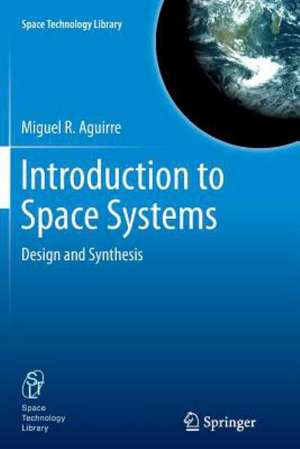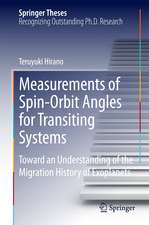Introduction to Space Systems: Design and Synthesis: Space Technology Library, cartea 27
Autor Miguel A. Aguirreen Limba Engleză Paperback – 19 sep 2014
Introduction to Space Systems is divided into two parts. The first part analyzes the process of space system design in an abstract way. The second part of the book focuses on concrete aspects of the space system design process. It concentrates on interactions between design decisions and uses past design examples to illustrate these interactions. The idea is for the reader to acquire a good insight in what is a good design by analyzing these past designs.
| Toate formatele și edițiile | Preț | Express |
|---|---|---|
| Paperback (1) | 1009.08 lei 6-8 săpt. | |
| Springer – 19 sep 2014 | 1009.08 lei 6-8 săpt. | |
| Hardback (1) | 1013.65 lei 6-8 săpt. | |
| Springer – 16 aug 2012 | 1013.65 lei 6-8 săpt. |
Din seria Space Technology Library
- 20%
 Preț: 569.37 lei
Preț: 569.37 lei - 17%
 Preț: 363.73 lei
Preț: 363.73 lei - 20%
 Preț: 476.04 lei
Preț: 476.04 lei - 18%
 Preț: 947.98 lei
Preț: 947.98 lei - 15%
 Preț: 643.99 lei
Preț: 643.99 lei - 18%
 Preț: 1688.57 lei
Preț: 1688.57 lei - 18%
 Preț: 957.75 lei
Preț: 957.75 lei - 18%
 Preț: 1393.27 lei
Preț: 1393.27 lei -
 Preț: 393.35 lei
Preț: 393.35 lei - 18%
 Preț: 956.03 lei
Preț: 956.03 lei - 15%
 Preț: 647.08 lei
Preț: 647.08 lei -
 Preț: 429.69 lei
Preț: 429.69 lei - 24%
 Preț: 1057.68 lei
Preț: 1057.68 lei - 18%
 Preț: 1215.04 lei
Preț: 1215.04 lei - 24%
 Preț: 810.45 lei
Preț: 810.45 lei - 18%
 Preț: 960.78 lei
Preț: 960.78 lei - 18%
 Preț: 947.50 lei
Preț: 947.50 lei - 15%
 Preț: 584.92 lei
Preț: 584.92 lei - 15%
 Preț: 647.40 lei
Preț: 647.40 lei - 18%
 Preț: 1834.77 lei
Preț: 1834.77 lei - 15%
 Preț: 590.16 lei
Preț: 590.16 lei - 15%
 Preț: 600.30 lei
Preț: 600.30 lei - 15%
 Preț: 713.33 lei
Preț: 713.33 lei - 23%
 Preț: 739.84 lei
Preț: 739.84 lei - 18%
 Preț: 998.66 lei
Preț: 998.66 lei - 23%
 Preț: 748.98 lei
Preț: 748.98 lei
Preț: 1009.08 lei
Preț vechi: 1230.59 lei
-18% Nou
Puncte Express: 1514
Preț estimativ în valută:
193.11€ • 200.39$ • 161.41£
193.11€ • 200.39$ • 161.41£
Carte tipărită la comandă
Livrare economică 17-31 martie
Preluare comenzi: 021 569.72.76
Specificații
ISBN-13: 9781489989154
ISBN-10: 1489989153
Pagini: 512
Ilustrații: XXX, 482 p.
Dimensiuni: 155 x 235 x 27 mm
Greutate: 0.71 kg
Ediția:2013
Editura: Springer
Colecția Springer
Seria Space Technology Library
Locul publicării:New York, NY, United States
ISBN-10: 1489989153
Pagini: 512
Ilustrații: XXX, 482 p.
Dimensiuni: 155 x 235 x 27 mm
Greutate: 0.71 kg
Ediția:2013
Editura: Springer
Colecția Springer
Seria Space Technology Library
Locul publicării:New York, NY, United States
Public țintă
ResearchCuprins
Chapter 1: Introduction.- Chapter 2: Space Disciplines.- Chapter 3: Requirements, Specifications, and Design.- Chapter 4: Constraints and Design.- Chapter 5: System Design as a Synchronic Process.- Chapter 6: System Definition as a Diachronic Process.- Chapter 7: Introduction to the Design Domains.- Chapter 8: The Observables and Instruments Domain.- Chapter 9: The Orbit and Attitude Domain.- Chapter 10: The Satellite Configuration Domain.- Chapter 11: The Operational Data Flow Domain.- Chapter 12: The Instrument Output Data Flow Domain.- Chapter 13: Space Missions Cost and Alternative Design Approaches.- Index.
Notă biografică
Miguel A. Aguirre Cid received a Masters in Aerospace Engineering from the Polytechnic University of Madrid. He started working in the field of space mechanisms; first for the Spanish company Sener and then later for the European Space Agency. Since 1990, the author has worked in the preliminary design of space missions in the ‘Future Missions Division’ of the Earth Observation Directorate of the European Space Agency. During this time, Aguirre has designed a variety of space missions both related to pure Earth science and to Earth-related operational applications.
Textul de pe ultima copertă
The definition of all space systems starts with the establishment of its fundamental parameters: requirements to be fulfilled, overall system and satellite design, analysis and design of the critical elements, developmental approach, cost, and schedule. There are only a few texts covering early design of space systems and none of them has been specifically dedicated to it. Furthermore all existing space engineering books concentrate on analysis. None of them deal with space system synthesis – with the interrelations between all the elements of the space system. Introduction to Space Systems concentrates on understanding the interaction between all the forces, both technical and non-technical, which influence the definition of a space system. This book refers to the entire system: space and ground segments, mission objectives as well as to cost, risk, and mission success probabilities.
Introduction to Space Systems is divided into two parts. The first part analyzes the process of space system design in an abstract way. The second part of the book focuses on concrete aspects of the space system design process. It concentrates on interactions between design decisions and uses past design examples to illustrate these interactions. The idea is for the reader to acquire a good insight in what is a good design by analyzing these past designs.
Introduction to Space Systems is divided into two parts. The first part analyzes the process of space system design in an abstract way. The second part of the book focuses on concrete aspects of the space system design process. It concentrates on interactions between design decisions and uses past design examples to illustrate these interactions. The idea is for the reader to acquire a good insight in what is a good design by analyzing these past designs.
Caracteristici
Constitutes a unique space system design book considering the different space system components from the point of view of their interaction and how the different components fit together Concentrates first on the space system design that will be performed because a new space system is approved to be a fully funded space project Studies the decisions, interactions, trade-offs and functional and numerical allocations which constitute the process of design




















